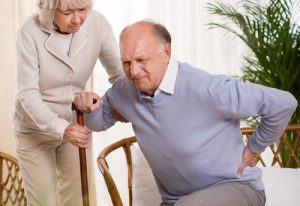Overview
Degenerative disc disease (also called spondylosis) is a general term used to describe changes that can occur along any area of the spine (cervical, thoracic, lumbar) as you age. It’s not actually a disease, but rather a condition in which your discs “degenerate,” or lose their flexibility and ability to cushion your spine. Your discs do not have a good blood supply, so once injured it tends to deteriorate in a cascade rather than heal. These age-related changes include:
- Discs dry out and shrink – made of mostly water, as you get older the discs slowly lose water. This loss of shock absorption and flexibility puts more stress on the annulus because the mechanics of the disc are altered.
- Small tears occur in the annulus – sometimes some of the gel-like material, or nucleus pulposus, comes out through a tear in the wall and touches the nerves. This material has many inflammatory proteins that can inflame the nerves and cause pain. These tears also affect the nerves in the annulus, and small movements, called micro-movements, can cause discogenic pain. Over the years the proteins eventually dry up, and the discs become stiffer; in some people this results in less pain by the time they are in their sixties.
- Disc space gets smaller – due to the loss of water in the discs the distance between vertebrae begin to collapse, which is one reason we get shorter as we age.
- Bone spurs grow – without the discs holding apart the vertebrae, they can rub on each other causing abnormal bone growths.
- Spinal canal narrows – the stresses of all the above changes causes the ligaments and facet joints to enlarge (hypertrophy) as they try to compensate and spread the load over a larger area. This over-growth causes the spinal canal to narrow, which can compress the spinal cord and nerves causing pain.
Symptoms
The symptoms of degenerative disc disease vary from person to person. Many people with deterioration have no pain, while others may experience pain so intense that it interferes with daily activities. Interestingly, even though this condition affects people starting in their twenties or thirties, people in their sixties are less likely to have back pain caused by deteriorated discs.
Pain often starts in one of three ways: (1) a major injury followed by sudden and unexpected pain, (2) a trivial injury followed by sudden back pain, and (3) pain that starts gradually and gets progressively worse.
Usually, the pain begins in the lower back, and may be felt in one or both of your legs and buttocks (sciatica) if there is nerve compression. It’s often described as pressure or burning pain. You may also feel numbness or tingling in your leg and foot, or have weakness in your leg muscles.
You may have chronic underlying pain that is a nagging annoyance and occasional episodes of intense muscle pain from time to time. These episodes last from a few days to a few months.
Sitting and especially bending forward usually causes the most pain because in this position your discs have more weight on them. Activities such as bending or twisting usually make your pain worse, and lying down tends to relieve the pain.
Causes
Doctors don’t exactly know what causes degenerative disc disease or why some people experience pain and others do not. Most abnormalities relating to DDD can be seen on an MRI—an imaging scan that shows the parts of your back in clear detail. While a large portion of people with back pain have abnormalities confirmed by MRI, studies on healthy young adults have shown that as many as 80% of people without pain also have abnormalities that can be seen on an MRI scan.
It’s not known why some people have pain and others don’t, but various factors contribute to disc degeneration including: genetic, environmental, autoimmune, inflammatory, and traumatic factors in combinations and ways that aren’t yet understood.



